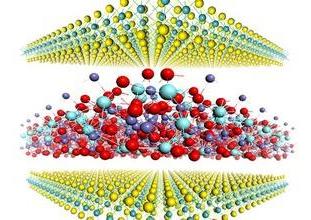Oct 1 2014
Graphene, a form of carbon in which a single layer of atoms forms a two-dimensional, honeycomb crystal lattice, conducts electricity and heat efficiently and interacts with light in unusual ways. These properties have led to worldwide efforts in exploring its use in electronics, photonics and many other applications.
 The EFRI 2-DARE project led by Alexander Balandin at the University of California, Riverside, will focus on a new class of ultra-thin film materials, termed van der Waals materials, and the synthesis of new structures with them. Credit: Mahesh Neupane, Roger Lake, and Alexander Balandin
The EFRI 2-DARE project led by Alexander Balandin at the University of California, Riverside, will focus on a new class of ultra-thin film materials, termed van der Waals materials, and the synthesis of new structures with them. Credit: Mahesh Neupane, Roger Lake, and Alexander Balandin
Rapid advances in graphene research during the last decade have suggested tantalizing possibilities for other two-dimensional materials, each of which might have distinct and useful properties.
To investigate the promise of 2-D layered materials beyond graphene, the National Science Foundation's (NSF) Office of Emerging Frontiers in Research and Innovation (EFRI) recently awarded grants totaling close to $18 million. NSF collaborated closely with the Air Force Office of Scientific Research (AFOSR), which is planning to invest an additional $10 million through its Basic Research Initiative.
Over the next four years, nine teams involving a total of 42 researchers at 18 institutions will pursue transformative research in the area of 2-D atomic-layer research and engineering (2-DARE).
EFRI 2-DARE researchers will explore fundamental materials properties, synthesis and characterization, predictive modeling techniques and scalable fabrication and manufacturing methods to create new devices for photonics, electronics, sensors and energy harvesting. They also will investigate forming such devices on flexible, transparent and conformal substrates.
The EFRI 2-DARE researchers will seek out 2-D layered materials and systems that offer enhanced and new capabilities in thermal storage, thermoelectric performance, gas adsorption and other areas. The rich variety of properties these materials and systems offer potentially can be engineered on demand.
"These nine projects offer opportunities for fundamental scientific exploration by unveiling the unique properties of these exciting 2-D monolayer membranes, and for harnessing these properties to spur device research that can enable technological breakthroughs," said Anupama Kaul, who coordinated EFRI 2-DARE during her rotation as an NSF program officer. "The teams will also contribute to the advancement of scalable synthesis routes and the nanomanufacturing of these materials, which can help seed translational research opportunities for these materials in the future."
The 2-DARE projects for EFRI are listed below.
Alexander Balandin of the University of California, Riverside (UCR), will lead the project "Novel Switching Phenomena in Atomic Heterostructures for Multifunctional Applications" (1433395) in collaboration with Alexander Khitun of UCR, Roger Lake of UCR, and Tina Salguero of the University of Georgia.
David Cobden of the University of Washington will lead the project "Spin-Valley Coupling for Photonic and Spintronic Devices" (1433496) in collaboration with Arka Majumdar of the University of Washington, David Mandrus of the University of Tennessee, Di Xiao of Carnegie Mellon University, and Xiaodong Xu of the University of Washington.
Joshua Goldberger of The Ohio State University will lead the project "Enhancing Thermal and Electronic Properties in Epitopotaxial Ge/Sn Graphane Heterostructures" (1433467) in collaboration with David Broido of Boston College, Dave Cahill of the University of Illinois, Urbana-Champaign, Joseph Heremans of The Ohio State University, and Li Shi of the University of Texas, Austin.
Yu Huang of the University of California, Los Angeles (UCLA), will lead the project "Scalable Synthesis of 2-D Layered Materials for Large Area Flexible Thin Film Electronics" (1433541) in collaboration with Xiangfeng Duan of UCLA, Kang L Wang of UCLA, and James De Yoreo of the University of Washington.
Lincoln Lauhon of Northwestern University will lead the project "Scalable Growth and Fabrication of Anti-Ambipolar Heterojunction Devices" (1433510) in collaboration with Mark Hersam of Northwestern University, Mark Lundstom of Purdue University, and Tobin Marks of Northwestern University.
Joan Redwing of The Pennsylvania State University will lead the project "2-D Crystals formed by Activated Atomic Layer Deposition" (1433378) in collaboration with Penn State colleagues Nasim Alem, Thomas Jackson, Ying Liu and Suzanne Mohney.
Joshua Robinson of The Pennsylvania State University will lead the project "Ultra-Low Power, Collective-State Device Technology Based on Electron Correlation in Two-Dimensional Atomic Layers" (1433307) in collaboration with Eva Andrei of Rutgers University, Suman Datta of Penn State, Roman Engel-Herbert of Penn State, and James Freericks of Georgetown University.
Humberto Terrones of Rensselaer Polytechnic Institute will lead the project "Design, Synthesis, Characterization and Device Fabrication of Transition Metal Dichalcogenides for Active and Nonlinear Photonics" (1433311) in collaboration with Ana Laura Elias of Penn State University, Zhiwen Liu of Penn State University, Yong Xu of Virginia Tech, and Lan Yang of Washington University in St. Louis.
Huili Grace Xing of the University of Notre Dame will lead the project "Monolayer Heterostructures: Epitaxy to Beyond-CMOS Devices" (1433490) in collaboration with Notre Dame colleagues Morten Eskildsen, Libai Huang, Debdeep Jena, and Tengfei Luo.
"If we want to be competitive in the innovation economy and to benefit society with exciting new technologies," said Sohi Rastegar, director of the EFRI program, "cutting edge fundamental science and engineering research like 2-DARE is indispensible."
The fiscal year 2014 EFRI 2-DARE topic was developed with significant input from the research community and in close collaboration between the NSF Directorate for Engineering and the NSF Directorate for Mathematical and Physical Sciences as well as with the AFOSR.